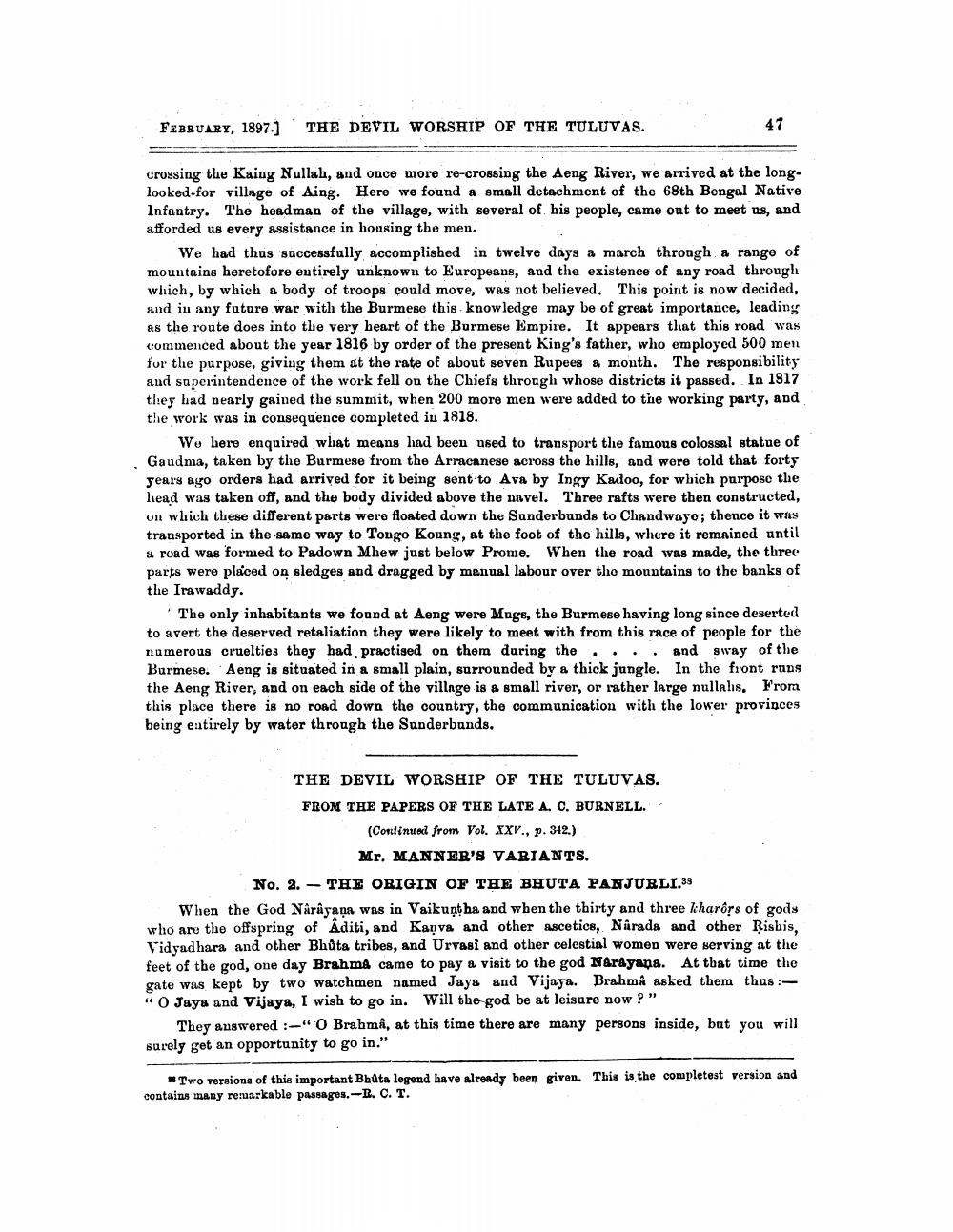________________
FEBRUARY, 1897.). THE DEVIL WORSHIP OF THE TULUVAS.
47
crossing the Kaing Nullah, and once more re-crossing the Aeng River, we arrived at the longlooked-for village of Aing. Here we found a small detachment of the 68th Bengal Native Infantry. The headman of the village, with several of his people, came out to meet us, and afforded us every assistance in housing the men.
We had thus successfully accomplished in twelve days a march through a range of mountains heretofore entirely unknown to Europeans, and the existence of any road through which, by which a body of troops could move, was not believed. This point is now decided, and in any future war with the Burmese this knowledge may be of great importance, leading as the route does into the very heart of the Burmese Empire. It appears that this road was commenced about the year 1816 by order of the present King's father, who employed 500 men for the purpose, giving them at the rate of about seven Rupees a month. The responsibility and superintendence of the work fell on the Chiefs through whose districts it passed. In 1817 they had nearly gained the summit, when 200 more men were added to the working party, and the work was in consequence completed in 1818.
Wo here enquired what means had been used to transport the famous colossal statue of Gaudma, taken by the Burmese from the Arracanese across the hills, and were told that forty years ago orders had arrived for it being sent to Ava by Ingy Kadoo, for which parpose the lead was taken off, and the body divided above the navel. Three rafts were then constructed, on which these different parts were floated down the Sanderbunds to Chandwayo; thence it was transported in the same way to Tongo Koung, at the foot of the hills, where it remained until a road was formed to Padown Mhew just below Prome. When the road was made, the three parts were placed on sledges and dragged by menual labour over the mountains to the banks of the Irawaddy.
The only inhabitants we found at Aeng were Mugs, the Burmese having long since deserted to avert the deserved retaliation they were likely to meet with from this race of people for the numerous cruelties they had practised on them during the .... and sway of the Burmese. Aeng is situated in a small plain, surrounded by a thick jungle. In the front runs the Aeng River, and on each side of the villnge is a small river, or rather large nullals. From this place there is no road down the country, the communication with the lower provinces being entirely by water through the Sunderbunds.
THE DEVIL WORSHIP OF THE TULUVAS. FROM THE PAPERS OF THE LATE A. O. BURNELL.
(Continued from Vol. XXV., p. 312.)
Mr. MANNER'S VARIANTS. No. 2.- THE ORIGIN OF THE BHUTA PANJURLI.39 When the God Narayana was in Vaikunt ha and when the thirty and three liharors of gods who are the offspring of Aditi, and Kanva and other ascetics, Narada and other Rishis, Vidyadhara and other Bhůta tribes, and Urvasi and other celestial women were serving at the feet of the god, one day Brahms came to pay a visit to the god Narayana. At that time the gate was kept by two watchmen named Jaya and Vijaya. Brahmå asked them thus :" O Jaya and Vijaya, I wish to go in. Will the god be at leisure now?"
They answered :-"O Brahmå, at this time there are many persons inside, but you will surely get an opportunity to go in."
#Two versions of this important Bhata legend have already been given. This is the completest version and contains many remarkable passages.-R. C. T.




